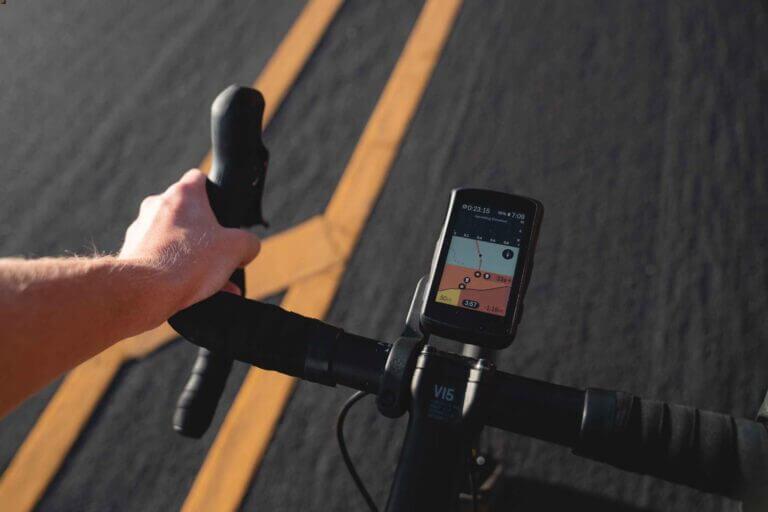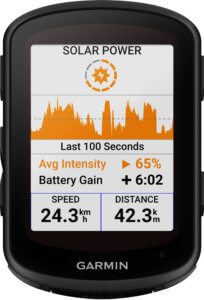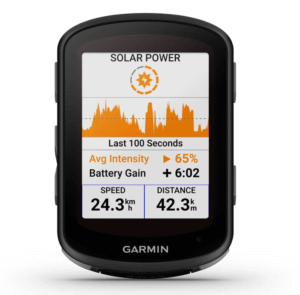In the ever-evolving world of cycling, where gadgets and gears intertwine with our rides, cycling computers have risen to become game-changers. They’re not just about crunching numbers; these nifty devices track our progress, guide us through routes, and even sync up with the digital world.
Fast forward to 2024, and it’s high time we take a closer look at the cream of the crop – the cycling computers that are here to reshape our two-wheeled adventures. In this article, we’ll delve deep into the intricacies of each device, showcasing their features, benefits, and how they can potentially revolutionize your cycling endeavors.
1. Garmin Edge 1040 Solar
2. Wahoo Elemnt Roam V2
3. Bryton Rider 420 E
4. Wahoo ELEMNT Bolt V2
5. Garmin Edge 840
6. Hammerhead Karoo 2
7. Garmin Edge 540
1. Garmin Edge 1040 Solar
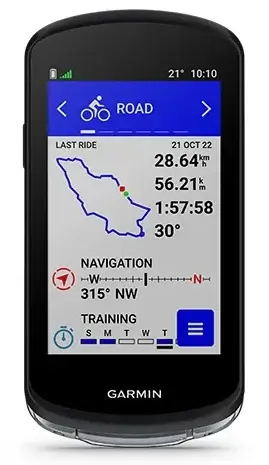
The Garmin Edge 1040 Solar emerges as the pinnacle of cycling computer innovation, boasting unmatched advancements for cyclists seeking peak performance. With the ability to remain operational for weeks without the need for recharging, this remarkable device ensures that your riding experience is never limited by battery constraints.
Setting itself apart in the cycling computer realm, the Edge 1040 Solar showcases the joint-largest color touchscreen in Garmin’s esteemed performance cycling lineup.
Sporting a generous screen size of 3.5 inches and a resolution of 700×282 pixels, it offers an interface that’s both intuitive and interactive. While three physical buttons handle essential functions like power and ride controls, the interface predominantly relies on touch-based interaction. Given its size, the included out-front mount becomes an indispensable accessory, ensuring a streamlined integration onto your handlebars.
The integration of solar charging technology into the Edge 1040 Solar significantly extends its battery life, ensuring a reliable power source even during multi-day rides. Whether you’re actively using the device or simply leaving it in direct sunlight while resting, the solar feature ensures consistent charging, regardless of whether the unit is powered on or off.
Beyond its exceptional solar capabilities, the Edge 1040 Solar is a treasure trove of functionalities, catering to a wide spectrum of riding preferences. Despite its impressive range of features, the device remains user-friendly, making it an ideal companion for all types of cycling pursuits.
It’s worth noting that the Edge 1040 is a substantial device, slightly heavier than other bike computers, and its advanced capabilities are reflected in its price tag. However, if you’re in search of a cycling computer that excels across all facets of cycling and beyond, the Garmin Edge 1040 Solar undoubtedly stands as the unparalleled choice.
2. Wahoo Elemnt Roam V2
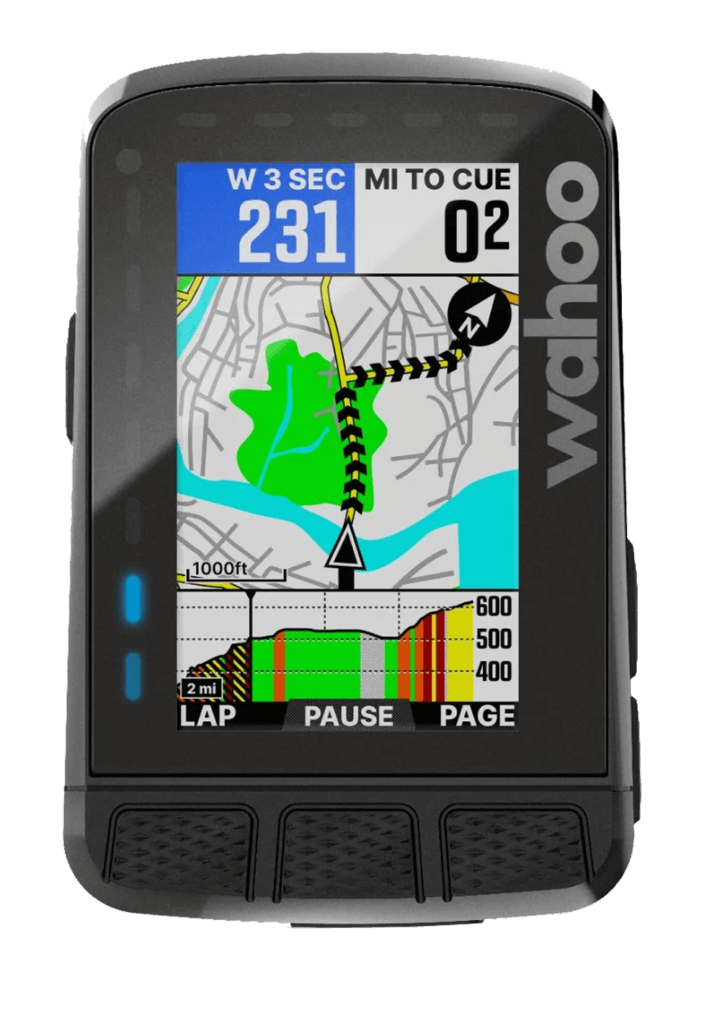
The Wahoo Elemnt Roam V2, an evolution of its predecessor, maintains the same form factor while introducing notable upgrades such as USB-C charging and a more vibrant, high-resolution display. Embracing user convenience, the Elemnt Roam V2 effortlessly stands out as one of the most user-friendly cycling computers on the market.
One of the standout qualities of the Elemnt Roam V2 is its seamless usability. Setting up this cycling computer is a breeze, thanks to an intuitive smartphone app that guides you through the initial configuration swiftly. Once configured, your rides are effortlessly synced to popular platforms like Strava, and routes or workouts are seamlessly transferred from common route-building websites.
While the setup process echoes that of the Elemnt Bolt, the Elemnt Roam V2 shines with its larger screen and extended battery life, elevating its day-to-day user-friendliness.
With a battery that endures for up to 17 hours, the Elemnt Roam V2 may not match the longevity of certain premium Garmin models, but it still ranks among the finest performers in the market, even rivaling the Hammerhead Karoo’s endurance.
The allure of the Elemnt Roam V2 lies in its inherent reliability. If you seek a cycling computer that simply gets the job done without fuss, Wahoo continues to be the brand of choice.
This latest iteration allows you to choose between the Roam V2 with an expanded screen and an additional two hours of battery life, or the slightly more compact Bolt V2, which offers a similar user experience at a slightly lower cost.
3. Bryton Rider 420 E
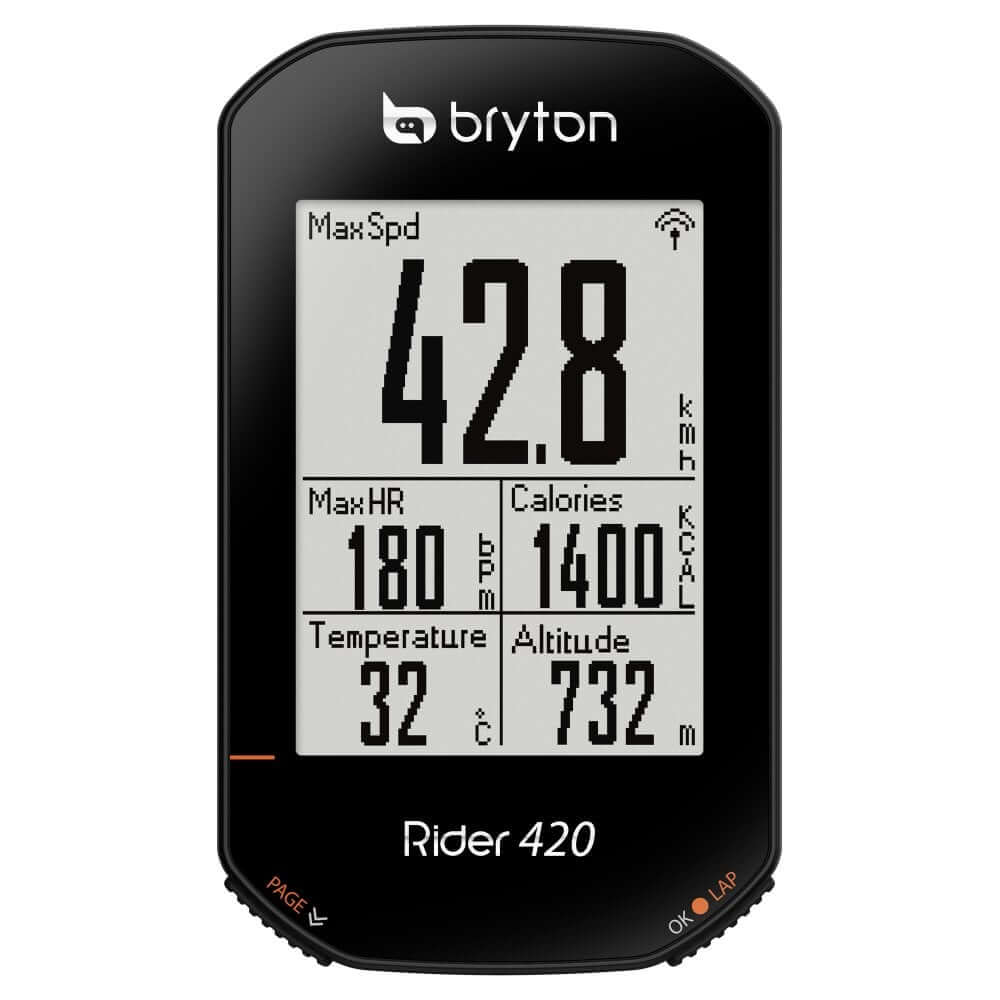
Positioned as a versatile mid-range companion, the Bryton Rider 420 E embodies a compact GPS computer that punches well above its weight in terms of technology and affordability. While it might not deliver an extensive mapping experience or offer interval timing, this cycling computer encompasses a host of functionalities in a compact and cost-effective package, making it an attractive choice for a wide range of cyclists.
Sporting a modest 2.3-inch mono LCD screen sans color touch capabilities, the Bryton Rider 420 E maximizes its compact display, delivering comprehensive data with a touch of old-school charm. Although it lacks the frills of detailed maps and Wi-Fi connectivity, the Bryton compensates with straightforward setup, user-friendly operation, and compatibility with various ancillary devices.
Intriguingly, the Rider 420 E is no slouch when it comes to features. It effortlessly pairs with ANT+ or Bluetooth-enabled heart rate monitors and power meters, offering comprehensive data such as altitude, distance, speed, and more. The inclusion of turn-by-turn navigation, albeit as a simplified line representation, enhances your ride guidance.
Charging the Rider 420 E is a breeze via the Micro USB port nestled on its underside, securely protected by a fitted rubber cover. Durability and build quality are evident in this unit, making it a resilient and trustworthy companion on your rides.
The Bryton Active App complements the Rider 420 E’s capabilities, enabling trail planning, importation of trails from third-party platforms, and seamless syncing with Strava, Komoot, and Ride. Boasting an impressive array of functions including time, speed, distance, calorie, altitude, power, and heart rate, this cycling computer ensures you’re well-equipped to analyze your performance.
While the Bryton Rider 420 E may not boast the most cutting-edge features, it excels in executing its functions seamlessly. While the buttons might present a minor challenge, the overall experience is gratifying, particularly with its navigation and power meter compatibility.
4. Wahoo ELEMNT Bolt V2
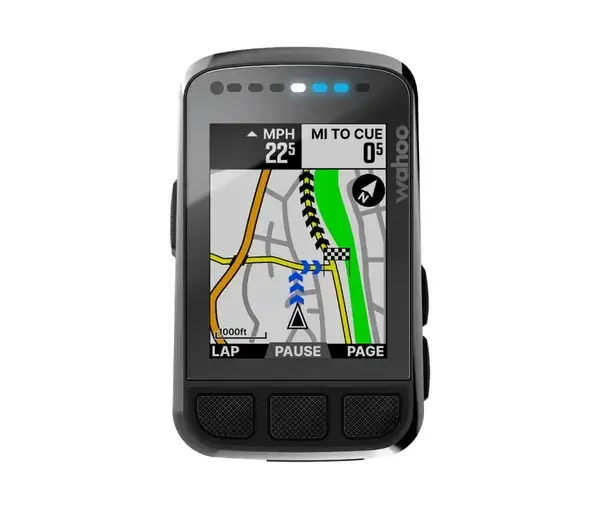
Wahoo’s second-generation Elemnt Bolt V2 emerges as an exceptional cycling computer, encapsulating vital features within its compact frame. This bike computer presents an upgraded color screen, intelligent navigation, USB-C charging, and extended battery life compared to its predecessor, all contained within the same aerodynamic profile.
Designed to cater to the mapping and data demands of performance-driven cyclists, the Elemnt Bolt V2 shines in its simplicity and functionality, albeit with some limitations in detailed navigation. With a screen size of 2.2 inches, slightly smaller than the Roam’s 2.7 inches, the Bolt V2 maintains its sleek profile while providing a crisp visual interface.
Controlled by six tactile buttons, the Elemnt Bolt V2’s setup and data customization seamlessly unfold through the Elemnt companion app. Setting up the device is a breeze – power on the computer, scan the QR code with your smartphone, and the process intuitively progresses.
Customizing data screens via the app remains straightforward, enabling you to tailor ride data, navigation, Strava Live Segments, and more to suit your preferences. Wahoo promises 15 hours of runtime, conveniently supplemented by USB-C charging. Charging through USB-C takes under two hours.
Data capabilities of the Elemnt Bolt V2 are extensive, with over 20 categories offering diverse data fields for personalized custom pages. The LED strip across the top of the computer provides real-time information, reflecting your efforts, wrong turns, and other relevant metrics.
While sporting a smaller screen than its sibling, the Roam, the Elemnt Bolt V2 retains its exceptional functionality and usability. It boasts 16GB of memory, a vivid 64-color screen, smart navigation, and an augmented battery with minimal weight increase.
The improved tactile experience with convex buttons enhances user interaction, and Wahoo’s claimed 15 hours of runtime holds true. The Elemnt Bolt V2 excels in nearly every aspect except for navigation, where some room for refinement remains.
With its transition to a color screen being a significant update, the Elemnt Bolt V2 features enhanced tactile buttons and a user-friendly interface. Although its screen size might be a consideration based on your riding style, whether you’re exploring or sticking to familiar routes, the Bolt V2 proves its worth.
5. Garmin Edge 840 Solar
The Garmin Edge 840 Solar is a cycling computer that combines a range of practical features within a compact design. Boasting an impressive touchscreen, the addition of buttons is a welcomed touch for users who cycle with gloves on.
Efficiently performing the fundamental functions of a cycling computer, the device swiftly connects to satellites and bike sensors, ensuring you can focus on your ride.
With the inclusion of GNSS (Global Navigation Satellite System) connectivity, GPS data accuracy reaches new heights. Innovative features like Climb Pro 2.0, Climb Explore, and music controls enhance the overall user experience.
Maintaining the sleek design of its predecessor, the Edge 840 Solar is slightly longer and thicker, striking a perfect balance between screen size and a compact handlebar feel at 57.8×85.1×19.6mm and 88.9g.
Notable features such as ClimbPro, which profiles climbs longer than 500 meters and steeper than a 3 percent grade, contribute to its impressive functionality.
The Edge 840 Solar comes in two versions – one with solar panels and one without. While the solar functionality can extend battery life on sunny days, the added cost may not be justified for those in frequently cloudy locations.
Despite its efficiency, the £70/$50 extra for solar charging may not significantly boost battery life in less sunny regions. Unless you consistently ride in sunny weather, the standard version with USB-C charging provides sufficient power for most users.
The Garmin Edge 840 Solar offers an outstanding combination of features in a compact device, making it one of the best bike computers available.
6. Hammerhead Karoo 2
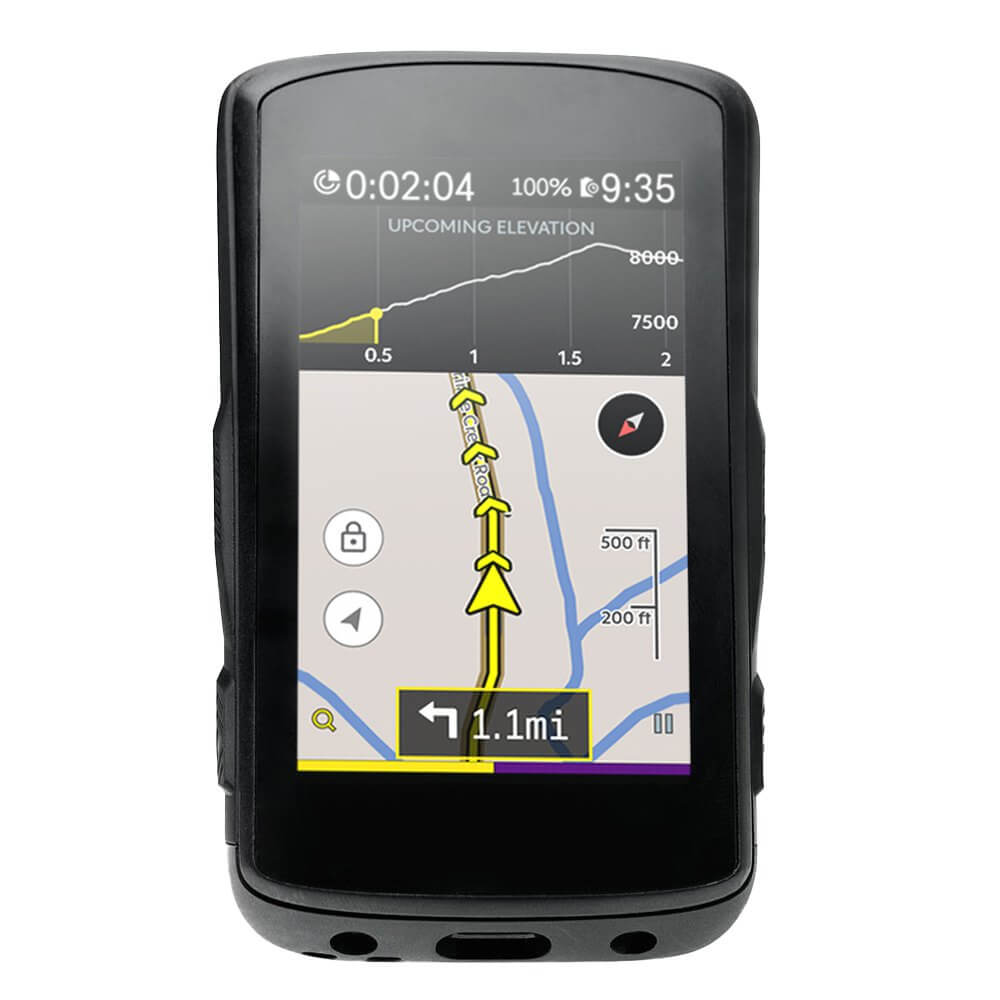
The Hammerhead Karoo 2, although not immediately synonymous with bike computer excellence, proves to be a compelling contender in a field dominated by giants like Wahoo and Garmin. With a forward-thinking approach, the Karoo 2 offers a refreshingly smartphone-esque experience while delivering a suite of features that are nothing short of impressive.
Measuring 100.6×60.8×19.3mm and weighing 132g, the Karoo 2 embodies a compact yet substantial unit, surpassing rivals like the Wahoo Elemnt Roam in size, thanks to its larger, high-resolution 3.2-inch touchscreen boasting 480×800 pixels. Unlike its counterparts, the Karoo 2 integrates a responsive touchscreen complemented by four physical buttons, enhancing device control and versatility.
Boasting 32GB of internal storage for data and maps, the Karoo 2 excels in practicality, supplemented by bi-weekly software updates and bug fixes from Hammerhead. The included plastic out-front mount, utilizing Hammerhead’s proprietary clip-in system, provides secure attachment, though slightly less seamless than Wahoo’s design.
Charging via USB-C enhances convenience and efficiency, while the Karoo 2’s advanced processor and expansive touchscreen set it apart from competitors. Its functionalities, including the innovative “Climber” feature displaying real-time climb profiles, match those of rivals while introducing unique attributes.
The Karoo 2’s connectivity prowess encompasses Bluetooth, ANT+, WiFi, Smartphone, GPS, 3G, and 4G capabilities, allowing seamless communication with a variety of devices across platforms.
However, the Karoo 2’s Achilles’ heel is its battery life, hovering around 9 hours, lagging behind competitors like Wahoo’s Elemnt Bolt (15 hours) and Garmin’s Edge 830 (20 hours). This limitation might warrant consideration for longer rides or adventures.
Navigational accuracy and detail on the Karoo 2 are exemplary, making it a potent rival in the top-tier bike computer segment. Its sleek aesthetics, intuitive interface, and standout touchscreen position it as a compelling alternative for discerning cyclists seeking innovation.
While the Karoo 2 might not be the most budget-friendly option, it’s certainly not the priciest either, making it an appealing choice for those seeking a fresh and distinctive alternative in the market. Despite the battery trade-off, the Karoo 2 impresses with its array of features and robust performance, solidifying its place among the best cycling computers available today.
7. Garmin Edge 540 Solar
The Garmin Edge 540 Solar steps up as a worthy successor to the Edge 530, offering users two options: the base version or the solar variant. Both share identical features and physical dimensions, with the only distinction being the inclusion of solar panels in the latter.
In comparison to its touchscreen-equipped counterparts like the Edge 840 and Edge 1040 series, the Edge 540 operates solely through its seven buttons. Navigating menus and starting/stopping rides are efficiently handled by these buttons, albeit with a slight learning curve due to the absence of a touchscreen.
The Edge 540 impressively covers more than the average cyclist needs while maintaining a price tag that’s less than half of the Garmin 1040 Solar. The addition of new features like the ClimbPro mode, offering real-time climb information without pre-loaded courses, enhances its appeal.
However, the solar charging functionality, while intriguing, comes with some nuances. Leaving it in the sun won’t charge the device unless it’s powered on, and the solar contribution primarily slows down battery discharge rather than dramatically increasing the battery percentage. Users looking for a more extensive screen and touch interface might find the Edge 540 lacking in comparison to the Edge 840.
For those who prioritize functionality and cost-efficiency, the non-solar Garmin Edge 540 provides an abundance of features at a compelling price point. On the other hand, if touchscreen convenience is a priority, the Edge 840 may be worth the additional investment.
The Edge 540 Solar finds its sweet spot for users who value functionality but are willing to compromise on screen size and touch controls.
Summary: Making the Right Choice for You
Selecting the right cycling computer from the diverse range of options, requires a careful consideration of your specific needs.
For those seeking unparalleled sophistication and advanced features, the Garmin Edge 1040 Solar stands out with its impressive touchscreen and solar-charging capabilities, ideal for long rides and multi-day adventures. On the other hand, the Wahoo Elemnt Roam V2 offers a user-friendly experience, making it an excellent choice for hassle-free setup and navigation.
Riders who value compactness and affordability without compromising functionality might find the Bryton Rider 420 E appealing, while the Wahoo Elemnt Bolt V2 excels in simplicity and performance. If you’re after a robust GPS unit with a touch of smartphone-like experience, the Hammerhead Karoo 2 might be your match, though consider its battery life for longer rides.
For the performance-oriented enthusiast, the Garmin Edge 840 and Edge 540 both offer comprehensive metrics and navigation features. While the Edge 840 boasts a touchscreen and larger screen, the Edge 540 offers similar capabilities through physical buttons, making it a budget-friendly alternative.
Ultimately, the right choice depends on your preferences, budget, and the specific features that align with your cycling style, ensuring a satisfying and efficient riding experience.
The Role of Cycling Computers in Training
Gone are the days when cycling computers were mere odometers. They have evolved into comprehensive training companions that provide real-time insights to cyclists, enabling them to monitor their performance while pedaling.
This transition from rudimentary data displays to sophisticated training tools has elevated cycling computers to the forefront of cycling technology. Equipped with features like heart rate monitoring, power measurement, and GPS tracking, these devices have become essential for any cyclist serious about optimizing their performance.

Key Features to Look for in a Cycling Computer
The selection process for a cycling computer goes beyond aesthetics. Key features play a critical role in shaping your experience on the saddle. GPS functionality, for instance, allows cyclists to explore new routes confidently, providing turn-by-turn navigation to ensure you never lose your way.
Seamless wireless connectivity facilitates the effortless transfer of data, helping you analyze your rides without any hassle. Data display quality, battery life, and compatibility with other devices should also be carefully considered to ensure the cycling computer aligns with your specific needs.

